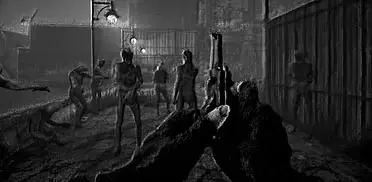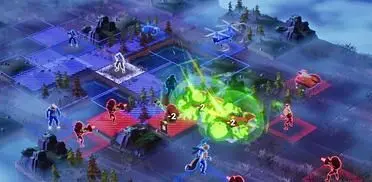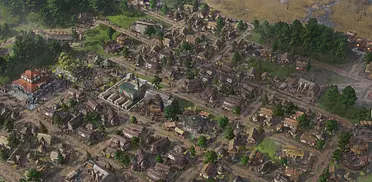As hordes of knowledge-hungry visitors slalom through haphazardly placed prehistoric exhibits – sometimes blocking staff from extinguishing a nearby fire – a PA announcement blares over my museum’s speakers. It reminds everyone that they must leave with as many bones as they entered, “no more, no less.”
Two Point Museum embodies the same goofy, chaotic, and casually minded management sim energy as its predecessors. But while it asks you to dig deep and explore the stars in search of valuable artifacts, Two Point Studios’ third effort also keeps things a little safe.
Overseeing the county’s museums puts you through many of the same motions as the prior two games. You have to hire, train, and manage staff, keep finances in the black, and make more space for the artifacts you secure by purchasing new plots of land. In the campaign, you build five museums from the ground up, gradually uncovering six exhibit themes and their mechanical twists.
Complete several sets of objectives, and your institution earns a star. Earn enough of them, and your curator class increases, allowing you to take your museums to new heights while unlocking fresh locations. It’s certainly a familiar campaign structure, but pre-built pop-up exhibitions that have you focusing on a single aspect – like marketing or security – as you chase high scores offer a few neat distractions.
Keeping hired staff happy involves tracking their salary expectations, which grow as they improve their skills. The museum must also keep its staff fed and energized while offering them a space to rest and heal from injuries. Assigning them specific jobs based on the museum’s shifting needs is key to keeping everything running. Otherwise, your leading explorer may hang back to clean the dust off exhibits while the person trained to restore them makes a feeble attempt at navigating a planet made entirely of cheese.
Dedicated rooms primarily cover staff facilities this time, but you can use – a somewhat limited selection of – walls, doors, and fences to separate your museums into themed sections. Doing so also allows you to guide foot traffic in specific directions, have better security camera coverage – so thieves don’t vandalize or run off with valuable exhibits – and create entry points only staff can access.
I tinkered with all of them but always found myself embracing chaos by plopping down exhibits next to each other, giving guests and staff just enough space to squeeze past them. Did this approach result in people frequently getting stuck or my hires watching helplessly as exhibits caught fire and exploded, causing a mess? Perhaps. But my profits kept going up while visitors still got the cultural experience of a lifetime, even if giving their brain cells a workout also involved stepping into stray puddles of cheese or vomit every now and then.
In true series fashion, Two Point Museum continues to accommodate both casual players and those who favor efficiency. Rather than directly focusing on the needs of your guests – largely faceless figures whose sole purpose is to buy your overpriced drinks and onesies – you shift attention to ensuring that your artifacts stay in prime condition, have enough buzz to make visits enjoyable, and provide as much knowledge as possible.
All these factors impact the museum reviews and the donations the guests leave. The latter represent a large chunk of your income, which you can supplement by selling items in the gift shop, vending machines, or via sponsored items and loans.
Keeping exhibits in top shape and decorating their surroundings increases their buzz while making visiting your museum less dreary for guests. To increase knowledge, you’ll need to feed artifacts into an analysis machine and have an expert deconstruct them. The process is generally smooth, allowing you to put low-rarity artifacts to good use while freeing up space for their more valuable versions, which provide more buzz.
Different guest types look for different things – professors value knowledge more, and children prefer interactive displays over boring info stands – but micromanagement never feels necessary outside of focusing marketing campaigns on a specific type of visitor when mission objectives demand it.
Expeditions are a core addition to Two Point Museum. You send staff to different locations worldwide – and sometimes beyond – to retrieve different artifacts. Each point of interest has varying staff requirements and a series of positive and negative events.
You can trigger or avoid some of them by making use of items crafted in the workshop or by selecting the staff with the appropriate level or skills. Some expeditions ask for a cumulative team rank to ensure none of your people go MIA; others let you avoid damaging your helicopter by bringing a proficient pilot.
This requires you to consider how you distribute skills when training staff and how their absence impacts the daily running of your museum. However, Recruiting enough people beforehand usually means you can get by, even if their training doesn’t fit like a glove.
A mixed set of skills could see staff easily replacing their peers who set off, but some expeditions do require you to specialize. Furthermore, seasons can add negative conditions, testing your patience unless you want to risk losing people.
Although their relevance never fades, Two Point Museum’s expeditions lose steam reasonably early on. Everything happens off-screen, so they never evolve past feeling like a mobile minigame that becomes increasingly repetitive.
In the worst cases, they hamstring progress through objectives, as you have to spam expeditions to a location or two to raise their survey level, increasing the rarity of artifacts you can obtain and the chance to get pristine pieces of the highest tier.
But even when they’re not egregious, the game’s more relaxed approach to difficulty means there’s nothing particularly high-stakes about them. If a staff member goes missing in action, you can hire and train someone new. More often than not, waiting for the current in-game season to pass while you level up staff in other expeditions ensures you can complete even the most challenging ones without sacrificing efficiency.
Occasionally, dilemmas pop up, requiring you to make choices that can grant your crew a boon or a debuff – like injuries, curses, illnesses, or the expedition taking longer – but their outcomes rarely matter. The event text is often brief and uninteresting, which is odd since, elsewhere, the writing is puntasticly humorous and on par with the quality of prior titles in the series.
Illnesses and curses can easily be cured by sending affected staff to specific points of interest. While their brief absence might have sometimes impacted a month’s profits, it never had any lasting effects. Although I wouldn’t call Two Point Museum’s expeditions a complete miss, the more I interacted with them, the more I wished for a feature that allowed me to automate the process.
Far better executed, the six different exhibit themes remain fresh as you switch museums. Prehistoric exhibits are the most straightforward, requiring a simple dusting here and there unless they’re frozen finds, in which case you’ll also need to lower their environment’s temperature.
After discovering their blueprints, science contraptions are built in the workshop using materials retrieved from expeditions. They’re far more likely to catch fire if they fall into disrepair.
You’ll also wrestle with the supernatural, housing more or less famed ghosts in a former hotel while making sure that their rooms fit their tastes enough for them not to think about escaping and scaring guests. Alien artifacts from beyond the stars activate when paired with others inscribed with the correct symbols.
Depending on the fish they house, aquariums require enough water filters, proper food, and temperature, alongside keeping tabs on which creature goes where. Put bigger pescatarian fish next to their smaller kin, and you’ll quickly discover that the latter makes for a good meal. Furthermore, you can also breed new fish for your aquariums with the right item.
Although these aren’t exactly seismic shifts in terms of gameplay, the mechanics confer enough personality to museums while making things approachable for casual players yet still providing adequate levels of depth. Mixing and matching them in the returning sandbox mode also allows you to prove that human beings, fish, and ghost yeti can, indeed, co-exist peacefully.
Performance
Two Point Museum ran without a single hitch on an i7-13700K, 32 GB RAM, and Nvidia RTX 3080@1440p. However, I encountered several issues with the review build, which lacked several level transition voiceovers. Occasional bugs also popped up, causing expeditions to not start until reloading the save.
Two more egregious examples involved a ghost refusing to disappear from my museum after getting angry at me enough times and perpetually taking up a slot in one of my rooms (although, in retrospect, that may just have been the right punishment). Worse yet, the supernatural museum ended up soft-locked as the objectives required to progress stopped appearing halfway through. Hopefully, a day-one patch will provide fixes.
TWO POINT MUSEUM VERDICT
Two Point Museum inhabits the same space as the other entries in the series, confidently maintaining approachable levels of depth. Although its campaign comprises fewer stages, they’re more involved. Managing staff, finances, and exhibits comes with a good amount of familiarity. Still, I always looked forward to creating the next cultural hellscape that only vaguely resembled an actual museum and still functioned.
While expeditions get old much too soon, the six exhibit themes on show alongside the oddball humor of item descriptions and radio shows do the heavy lifting, succeeding to offer enough reasons to see the campaign through and dabble in the sandbox mode. Two Point Museum continues to capture that olden Bullfrog charm expertly, but the series is starting to feel like it’s not far away from belonging in a museum.
TOP GAME MOMENT
Making a famous ghost really happy by finding its long-lost hat.
Good vs Bad
- Humor remains on-point
- Interesting exhibit themes
- Casual-friendly without lacking depth
- Fewer but more involved levels
- Expeditions become tedious too early
- UI feels a bit cluttered
- A little too familiar at times











